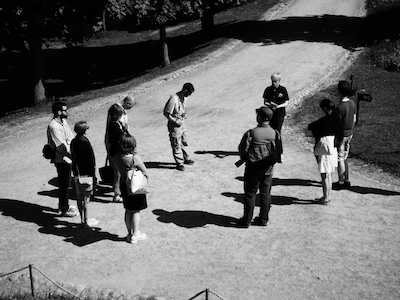Study Tour 2016 | Travel On
by Kristian C. Kohler (M.Div. ’16)
Travel on, travel on, there’s a spirit that is playing, the spirit plays like music every day. Travel on, travel on, with the music that is playing. The spirit will be with us all the way
-Sydney Carter
 I felt the spirit of encounter traveling with us throughout this year’s ISM Study Tour to Tallinn, Helsinki and Saint Petersburg. We were offered warm welcomes by many on our trip, both encountering some familiar faces from this year’s Colloquium series and making new introductions. In Tallinn, we met Father Mattias Palli at the Church of St. Simeon and the Prophetess Hanna (Estonian Orthodox). In Helsinki, we attended the St. Thomas Mass at Mikael Agricola Church (Evangelical Lutheran) and met afterward with the Reverend Pirjo Kantala and Mrs. Inna Vintturi. And in Saint Petersburg, we had the opportunity to meet with Father Alexander Sorokin at the Cathedral of the Icon of the Mother of God Feodorovskaya (Russian Orthodox), engaging in a fascinating discussion about the history, present experience, and future of religious life in the Russian Federation. For me, these were all experiences that ran much deeper than sightseeing and museums—they were authentic encounters with faithful people that allowed me a glimpse into their lives and worlds.
I felt the spirit of encounter traveling with us throughout this year’s ISM Study Tour to Tallinn, Helsinki and Saint Petersburg. We were offered warm welcomes by many on our trip, both encountering some familiar faces from this year’s Colloquium series and making new introductions. In Tallinn, we met Father Mattias Palli at the Church of St. Simeon and the Prophetess Hanna (Estonian Orthodox). In Helsinki, we attended the St. Thomas Mass at Mikael Agricola Church (Evangelical Lutheran) and met afterward with the Reverend Pirjo Kantala and Mrs. Inna Vintturi. And in Saint Petersburg, we had the opportunity to meet with Father Alexander Sorokin at the Cathedral of the Icon of the Mother of God Feodorovskaya (Russian Orthodox), engaging in a fascinating discussion about the history, present experience, and future of religious life in the Russian Federation. For me, these were all experiences that ran much deeper than sightseeing and museums—they were authentic encounters with faithful people that allowed me a glimpse into their lives and worlds.
In Tallinn we heard the personal witness of Fr. Palli who grew up a self-described nonbeliever and was baptized in 1985. I was fascinated by the question “what is the Estonian Church?” Throughout its history, Estonia has been a liminal border space between Catholic Poland, Lutheran Germany, and Orthodox Russia. What, then, is the Estonian religious identity? It did, from my perspective, seem to be marked by a certain amount of ecumenical cooperation. For example, Fr. Palli referenced joint statements between the Estonian Orthodox and Evangelical Lutheran churches. He told us about the rich history of religious life in Estonia, as well as the history of the Church of Simeon and Hanna, which was originally constructed by Russian sailors in the mid-1700s and underwent a major restoration from 1999 to 2007.
In Helsinki, we were fortunate to be able to attend the St. Thomas Mass (Tuomasmessu in Finnish), a service that takes place weekly on Sunday evenings at the Mikael Agricola Church. An ecumenical service that invites “doubters and seekers to celebrate, worship God, serve their neighbor, and grow together … named after the Apostle Thomas, who seemed to have more questions than answers in his faith,” it began in that space in 1988 and has now spread to churches through Finland, Sweden, Norway, Denmark, and Germany. The service follows the liturgical tradition of the Western Mass, yet it has been infused with the spirit of present-day ecumenism. Amazingly, each service is planned by a team of 50 to 70 people, all of whom are volunteers.

For me, this service was an oasis of calm amidst a busy trip. About halfway through our journey, it provided me the opportunity to rest, reflect, pray, and build community. After the service, we were invited to a wonderful reception hosted by St. Thomas Mass participants in the fellowship hall of the church. There, I was able to make new friends and learn from them what it was that kept them coming back to this service. This time for encounter was a gift that deepened our experience far beyond mere tourism, enabling us to connect and converse with those whom had so warmly welcomed us into their worship.
Throughout all of these encounters and more, what inspired me was the willingness of our hosts to welcome us into their sacred places and to share with us their stories, worship, music, and art. For me, this was what our study tour was about—a spirit of curiosity, exploration, and encounter. I thank God for this Spirit-filled travel.